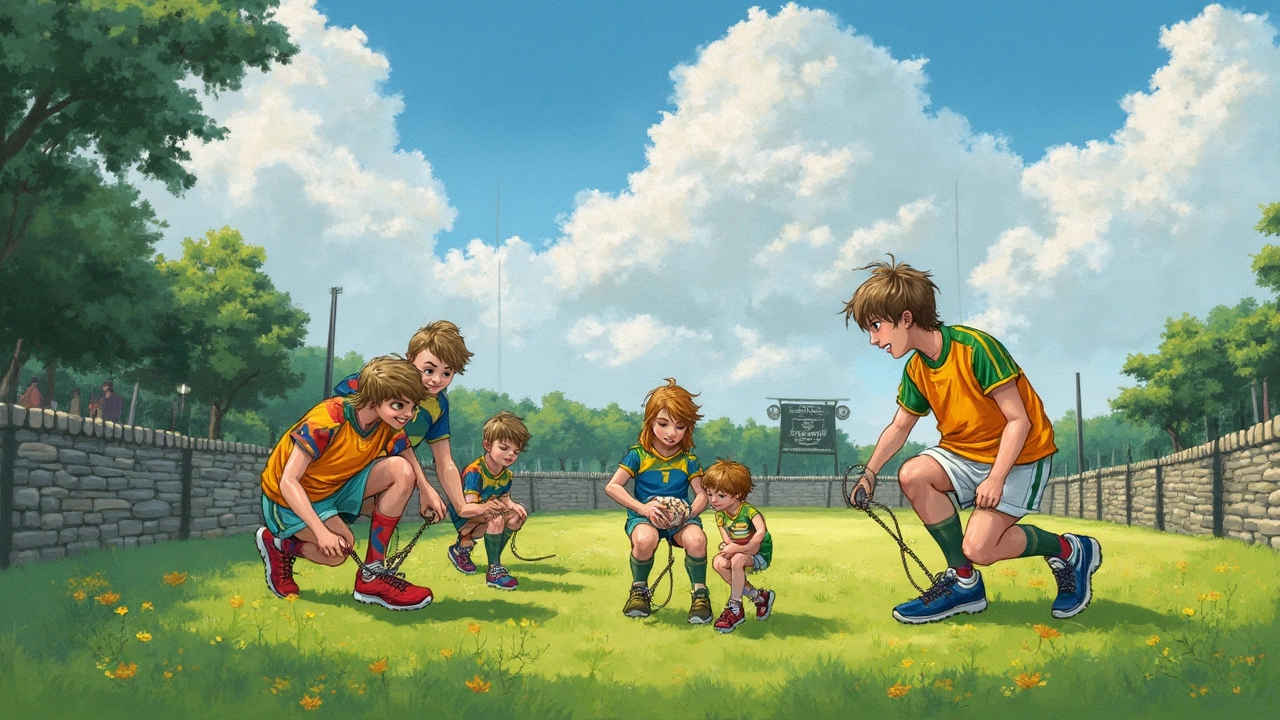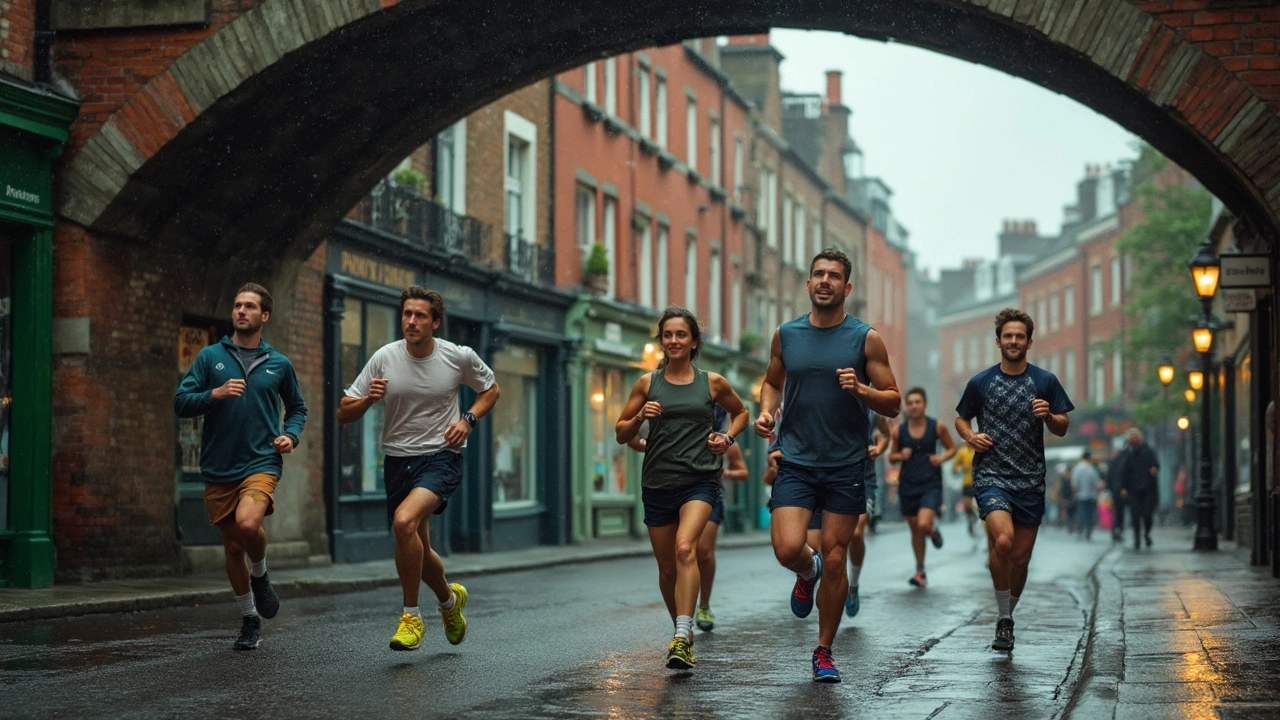If you ask for sneakers in a Dublin shop, you might get a blank look. In Ireland, it’s ‘trainers’—always has been. This isn’t just a quirky language thing; it shows how closely these shoes are woven into day-to-day life here. Whether you're nipping down to the Spar, walking the dog along the River Lee, or joining your local five-a-side, everyone’s got their favourite pair.
The story behind the name isn’t just for sneakerheads. Trainers carry their own Irish twist, shaped by decades of sport, culture, and rainy walks home from school. These aren’t just running shoes—they’re the unofficial footwear of Irish weekends, matched with GAA tops or paired with a 99 from Teddy’s in Dun Laoghaire. That term ‘trainer’ has roots going back to when sports coaches would urge sprinters around muddy local pitches, long before Nike Air Max ever hit the Irish shelves.
There’s more to it than just semantics. How trainers are used, which brands matter, and even how long your pair survives the local weather says a lot about life in Ireland. So, why does Ireland say ‘trainers’, and what makes them a local essential? Grab a cuppa, and let’s get into it.
- How Did ‘Trainers’ Become the Irish Word?
- A Brief History: From Gym Floors to Grafton Street
- Irish Brands, Trends, and Where to Buy
- Trainers for Irish Weather and Daily Life
- Tips for Choosing the Right Trainers in Ireland
How Did ‘Trainers’ Become the Irish Word?
People in Ireland don’t call them sneakers—they say trainers. You’ll notice the difference as soon as you chat with any local about shoes for the gym or casual wear. But why ‘trainers’? It comes straight from the words 'training shoes,' which first popped up in Britain back in the early 1900s when people needed footwear for athletics, not for street style.
While Americans started using ‘sneakers’—believing the soft soles made you sneak quietly—Irish folks stuck with trainers. The reason is simple: most Irish gear shops, even as far back as the 1950s, got their sportswear from UK brands like Dunlop, Gola, and later Adidas, all of which labelled them as trainers. Sneakers only really took off in American pop culture, and that just didn’t catch on here. Go to Elverys or Lifestyle Sports, and you’ll still see aisle signs for trainers, not sneakers.
The GAA (Gaelic Athletic Association) played a big role too. In the ‘60s and ‘70s when camogie and hurling teams started swapping boots for lighter, rubber-soled shoes at training, everyone began calling them trainers. Even matchday ads in old Irish newspapers—pages from The Irish Times or Evening Herald—would promote "training shoes" for schoolboys in the ‘80s. The local use of language stuck, because it fitted perfectly with Irish sport and school life.
Here’s how usage shifted across regions over time:
| Decade | Ireland | Great Britain | USA |
|---|---|---|---|
| 1950s | Training shoes | Plimsolls/Trainers | Sneakers |
| 1970s | Trainers | Trainers | Sneakers |
| 1990s | Trainers | Trainers | Sneakers |
| 2020s | Trainers | Trainers | Sneakers |
So, next time you’re picking up a pair before heading to Phoenix Park or planning a night out in Galway, you’ll know you’re calling them by the right Irish name. And if you ever ask for sneakers, don’t be surprised if you get pointed to the biscuit aisle instead.
A Brief History: From Gym Floors to Grafton Street
The story of trainers in Ireland starts way back, before they were everyday streetwear. In the early 1900s, what we call trainers today began as simple sports shoes, mostly used in gyms or at running tracks. They had flat rubber soles and canvas uppers—miles away both in style and performance from what you see scrolling JD Sports now.
It was the name “training shoe” that got shortened to ‘trainer’ by the 1920s in Britain and Ireland. The reason? These shoes were worn more often during sports training than in actual matches. Irish schools, especially in the 1960s and ’70s, started asking students to bring trainers for PE instead of heavy football boots. That set the trend—one that stuck hard and never really faded.
By the ’80s, trainers in Ireland broke out of the sports hall and into daily life. If you walked through Grafton Street in the mid-’90s, you’d see teenagers in Adidas Superstar or Nike Cortez, showing loyalty to their favourite GAA club with a county jersey. It was about comfort and street cred as much as sport. Big brands noticed the Irish affection for trainers and began flooding stores like Lifestyle Sports and Elverys with colourful ranges every summer.
Things really took off in the 2000s. Dublin skate shops sold chunky DCs, while city workers chose black runners (nobody called them "work shoes") for the Friday Luas dash. By now, the trainers trend had cemented itself as an essential part of Irish wardrobes. Even now, the ritual of heading to places like Kildare Village for the latest release is part of the culture.
So, what started in gyms turned into an identity. From GAA camps to music festivals at Marlay Park, trainers tell their own version of Irish history—one that’s still evolving on every street and pitch.

Irish Brands, Trends, and Where to Buy
When you talk about trainers in Ireland, brands matter—a lot. Nike and Adidas rule the streets, much like everywhere else, but there are some unique twists on Irish turf. O’Neills, for example, is a homegrown favourite for GAA fans. While they're better known for jerseys, O’Neills’ running shoes are padding out more and more Irish gym bags, especially for those supporting local industry.
Style-wise, white trainers have been massive in Ireland for the last few years. You’ll spot fresh pairs walking down Grafton Street, at gigs in Cork, or lining up outside Croke Park. Limited releases or collabs (like Nike Air Max and Adidas Gazelle reissues) get snapped up fast, so if you're after the newest drop, keep an eye on the main stores’ socials or sign up for alerts.
Now, where do you actually get them? Here’s where shopping feels very Irish:
- JD Sports and Lifestyle Sports are everywhere — both online and with handy high street shops in pretty much every Irish city and big town. They stock all the big names and some Irish exclusives.
- Shoe Lane in Galway is a solid independent if you want something different and some advice from staff who know their stuff.
- For bargains, outlets like Kildare Village have last season’s trainers for way less. Don’t write off TK Maxx either—a bit of digging uncovers proper gems on the cheap.
- If you like shopping at local businesses, lots of towns still have old-school shoe shops that stock brands you won’t get in chain stores, sometimes at lower prices than the online giants.
One thing to know: Irish weather can wreck the wrong pair in a week. That’s why Gore-Tex and waterproof options, like those stocked at Great Outdoors or outdoor shops in places like Westport and Killarney, sell well. If you’re out exploring the hills around Glendalough or braving Irish city puddles, a grippy sole and bit of weather resistance are golden. One last tip—always check if shops offer student discounts or loyalty points. It adds up, especially if you’re picking up the year’s second or third pair of trainers.
Trainers for Irish Weather and Daily Life
If you’re living in Ireland, you’ll know the weather has a mind of its own. Sometimes you get all four seasons in one day. So, the type of trainers you wear is a big deal—one minute you’re dodging puddles on Grafton Street, next you’re clambering up Howth Head in squally winds. Not every pair will survive a soggy Galway market or the salt and grit on Cork footpaths.
You need trainers that can handle rain, mud, and surprise hail. Mesh runners? Okay for the gym, but useless for darting between Luas stops in lashing rain. Lots of Irish people rate waterproof styles from big brands like Adidas, New Balance, or Nike, but don’t overlook local favourites—Intersport Elverys often brings in Dublin-proof lines with better grip than the average runner.
Here’s a quick look at what makes trainers work for daily life in Ireland:
- Water resistance: Avoid canvas or mesh for your everyday pair. Go for Gore-Tex or coated leather if you’re out and about daily.
- Good grip: Look for a chunky sole—slick pavements after rain get dangerously slippery, especially in city centres like Limerick or Waterford.
- Breathability: Even in wet weather, feet get sweaty, so a mix of water protection and breathability is key.
- Easy to clean: Irish mud sticks like nothing else. Leather or synthetic uppers clean up fast with a wipe.
- Style: Most want their trainers to work with jeans and sports gear—plain white runners never really go out of style in Ireland, but black and navy are popular for hiding dirt.
Ever wondered how long a typical pair lasts here? On average, Irish folks replace their main pair about every 12-16 months, usually because rain and all that city/suburban walking speed up wear and tear. Check out these common features and how many Irish people look for them when buying trainers:
| Feature | % of Irish Buyers Looking for It |
|---|---|
| Waterproofing | 70% |
| Durable Soles | 60% |
| Easy to Clean | 55% |
| Stylish Appearance | 50% |
If you’re commuting or walking the dog along the Grand Canal, swap out flimsy runners for something hard-wearing with a bit of grip. If you want trainers that actually last through an Irish winter, it’s worth paying that bit extra upfront. A couple of good pairs in rotation—one for messy days, one for dry—is a game-changer. This way, you’re sorted whether it’s sunny in Salthill or bucketing rain in Belfast.

Tips for Choosing the Right Trainers in Ireland
The Irish climate isn’t always friendly to shoes, so picking the right trainers means thinking about more than style. Rain, puddles, and the odd unexpected shower are part of the deal. Go for something with decent grip if you’re planning walks along the Grand Canal or hiking spots like Glendalough. You’ll thank yourself the next time it buckets down and your feet stay dry.
When it comes to materials, waterproof or at least water-resistant trainers are essential in Ireland, especially for anyone who gets around on foot or public transport. Mesh looks cool and is grand for indoors, but on a wet day in Galway it’ll have you squelching in no time. Leather or synthetic uppers usually handle Irish weather better.
If you’re big into Irish sport—like GAA, football, or rugby—choose trainers meant for specific surfaces. Most local sports shops like Elvery’s or Lifestyle Sports will have staff who know the difference between GAA boots and general gym trainers. As fitness coach Fiona O’Connor says:
"Always match your trainers to what you’ll actually do. You wouldn’t wear GAA boots in the gym, so don’t wear running trainers on a muddy field."
Irish roads and footpaths can get slippy, so pay attention to the tread. Trail trainers work a treat for the likes of Ticknock or Marley Park, but cushy, shock-absorbing soles are better if you’re pounding the city pavements from Heuston to St. Stephen’s Green.
- Try on trainers late in the day—your feet swell and you’ll get the real fit.
- Bring your usual socks when buying, so you won’t end up with a surprise squeeze.
- Check for proper arch support, especially if you stand or walk loads for work.
- Look for easy-to-clean materials. Dublin city grime is nobody’s friend.
- If you walk or run in the dark, consider trainers with reflective strips—safety first on Irish roads.
Don’t just pick by looks or brand hype. The right trainer makes all the difference whether you’re hitting a gym in Cork, joining Parkrun at Marlay Park, or dashing for the 46A bus. Keep comfort, weather, and your real routine in mind, and you’ll find a pair that works for you no matter where you are in Ireland.
